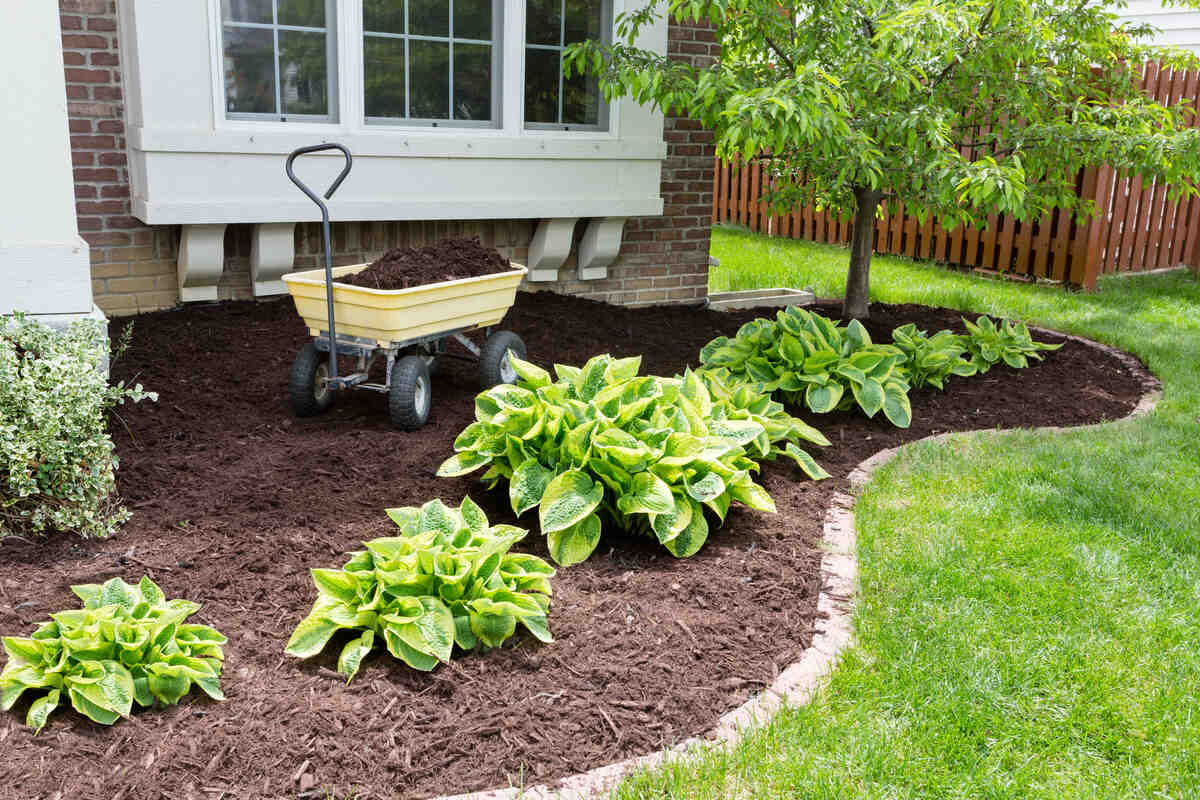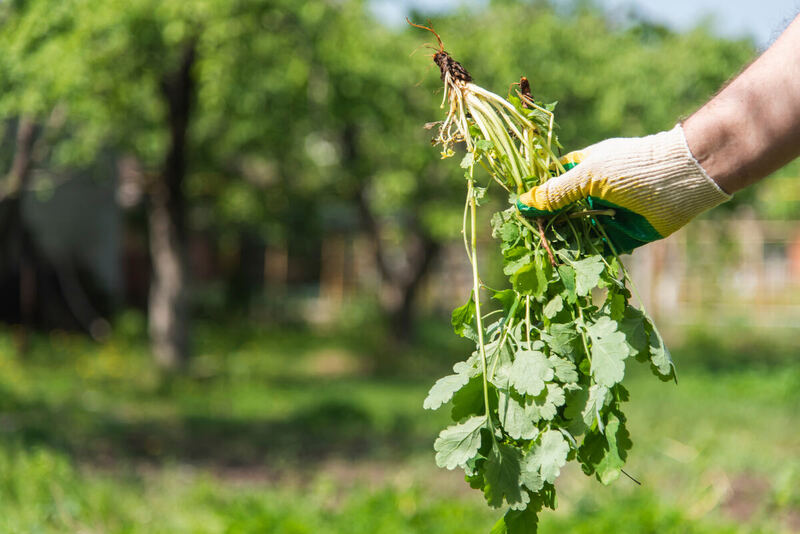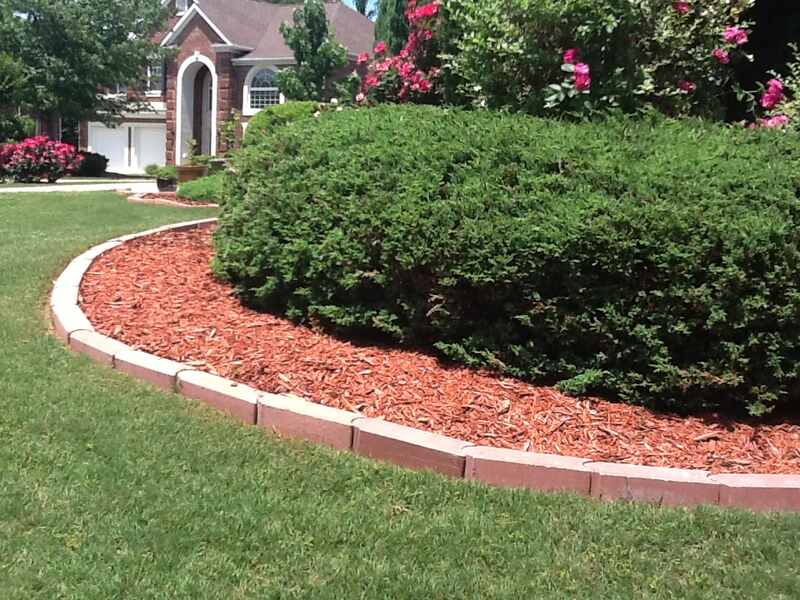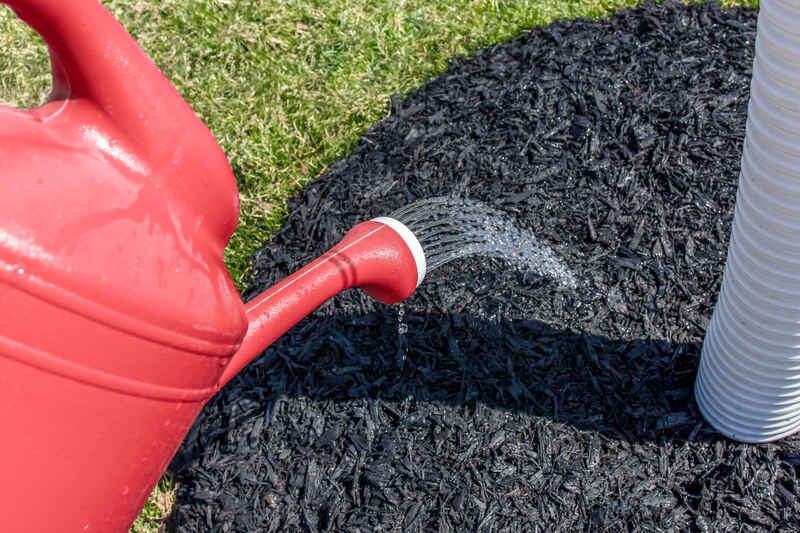
I love the smell of fresh mulch in the spring and the finishing touch it provides for the landscape. I’ll explain how to mulch your yard, from bed preparation to how to apply it correctly.
As a landscape designer, I’ve designed many landscape plans incorporating mulch for homeowners, determined the cubic yards needed for their garden beds, and overseen on-site applications.
| Project Difficulty: Beginner Estimated Time to Complete: 2 to 6 hours, depending on the size of the area. Project Cost: For DIY projects, mulch costs range from $20 to $180 per cubic yard for most types of mulch. If you hire someone, mulch installation costs range from $192 to $402 per cubic yard. |
Tools You’ll Need
Like any DIY project, having the right tools is important for accomplishing the task effectively and efficiently. Here is the equipment you’ll need to spread mulch in your yard:
- Garden rake
- Wheelbarrow
- Large shovel
- Pitchfork
- Edging tool
- Hoe
- Hand weeder
- Weed fork
- Garden hose
My Tip: Wear long sleeves, pants, and workboots while shoveling mulch (old “yard clothes” work best). Moist mulch sticks to everything (especially triple-ground) and can be prickly on your skin. If you have dyed mulch, it may also dye your clothes, especially if it’s wet.
If you’re unsure about delving into the mulch world or lack the strength or time to spread it yourself, contact a landscaping company for assistance.
Step 1: Preparation

Remove Weeds
Whether you’re hand-pulling your weeds or using post-emergent herbicides, getting rid of weeds is key to preparing the area for mulch.
See Related:
Edge Beds
Creating an edge between your garden bed and your lawn keeps your mulch contained. There are two ways you can create an edge:
- An edger (metal half-moon, rotary, or powered edger) creates a defined border along your garden bed.
- Garden edging is available in various styles, colors, and materials (including metal, stone, and plastic).
See Related:
Water the Soil
If you used a post-emergent herbicide to eliminate weeds, don’t water or apply mulch for at least 24 hours. However, after that period, you’ve got the green light to moisten the soil to promote the breakdown of organic materials.
Soaking the soil before mulching allows water to reach the roots directly rather than depending on slower absorption through the mulch.
Apply Pre-Emergent Herbicide
Apply pre-emergent treatments during both spring and fall. The landscape companies I worked for in Pennsylvania preferred granular formulations for straightforward application.
They would either sprinkle it over the soil before adding new mulch or apply it directly on existing mulch during a dry day. Then, they would rake the granules into the topsoil or mulch.
Note: Herbicides that are more resistant to degradation work best when applied on top of the mulch, as they can effectively bind to the organic materials within the mulch.
See Related:
Step 2: Calculate How Much Mulch You’ll Need

Whether you purchase bags of mulch or have it delivered in bulk to your driveway, it’s important to determine the amount you’ll need.
Let’s do some calculations. (If you’d rather not do the math yourself, skip ahead to our mulch calculator below to make this task simple.)
Here are the steps for calculating mulch by volume:
You’ll calculate in cubic feet (if buying bags) or cubic yards (if buying in bulk):
1. Start by calculating the area you want to cover in square feet.
How to calculate the area: For a square or rectangle area, multiply length x width (L x W). For a circle, use 3.14 x the radius squared (𝝅r²).
Ex. Rectangle bed 5 feet wide by 6 feet long = 30 square feet
2. Determine the mulch depth.
| Type of Bed | Mulch Depth |
| Vegetable gardens | 1 to 2 inches |
| Flower beds | 2 to 3 inches |
| Garden beds with trees and shrubs | 2 to 4 inches |
Ex. A 2-inch depth for a flower bed.
3. To calculate the volume, follow these steps:
- Multiply the area (in square feet) by the depth of the mulch (as a fraction of 1 foot; see ex. below). (This gives you cubic feet. If you want cubic yards, you have one more step below.)
- Then divide the result by 27 (since there are 27 cubic feet in a cubic yard).
Ex. Cubic feet: 30 x 1/6 (2 inches/12) = 5 cubic feet
Cubic yards: 5/27 = 0.185 cubic yards
Note: 1 cubic foot of mulch covers 6 square feet at a 2-inch depth. 1 cubic yard of mulch covers 162 square feet at 2 inches deep.
How to convert volume to weight:
If you’re considering using inorganic mulch such as pea gravel, some suppliers will sell it by the ton. (Others might sell it by the cubic yard.) Generally speaking, 1 cubic yard weighs approximately 1.33 tons. So, if you know how many cubic yards you need (volume) but the supplier sells it by weight, here’s how to do the math:
Cubic yards to tons: Cubic yards × 1.33 = tons
Ex. 1 cubic yard x 1.33 = 1.33 tons
Note: This is a general formula that works best for high-density materials like stone, gravel, and topsoil. Don’t use this formula to convert organic mulch, which is less dense, to tons (though organic mulch is almost never sold by weight).
Mulch Calculator
Mulch Calculator
Quick Mulching Tips
DON’T
- ❌ Pile mulch against tree trunks. This can cause bark rot and invite pests.
- ❌ Pile mulch against your house foundation
- ❌ Till carbon-rich mulch (e.g. sawdust) into the soil, it can tie up nitrogen.
DO
- ✓ Remove weeds before applying mulch
- ✓ Keep mulch 2-3 inches away from plant stems and 3-4 inches away from tree trunks
- ✓ Refresh mulch when it starts to decompose, usually annually.
If you want to discover more about measuring mulch and the costs associated with different types, check out these articles:
- How to Measure a Yard
- How Much Does Mulch Cost?
- How Much Does Pea Gravel Cost?
- Mulch Calculator: How Much Mulch Do You Need?
Step 3: Application Techniques

- Transport the mulch with a wheelbarrow: Using a wheelbarrow makes it easy to transport bagged or delivered mulch to your garden beds. Simply load the bags or scoop from the pile and deposit small, spreadable amounts throughout each bed.
- Start from the inside out: Think of spreading mulch like mopping a floor. Start at one end and work to the other to prevent stepping back onto the clean area. You don’t want footprints messing up your clean work.
- Taper the edge: Tapering the edge of mulch in garden beds involves gradually thinning it towards the perimeter. This creates a clean boundary and prevents plants from being smothered. After spreading, level the mulch with a rake for an even and tidy appearance.
Mulching Techniques for Specific Areas
When applying mulch in particular spots, such as flower beds or around trees, there are specific mulching techniques to consider:
- Vegetable gardens and flower beds: The mulch should not touch the plant’s stem. To ensure proper airflow, maintain at least 1 inch between the mulch and the stems.
- Garden beds with shrubs: Avoid piling mulch against the trunk of the shrub. Leave 3-5 inches between the trunk and the mulch.
- Trees: Avoid putting mulch within 6 inches of the trunk. After that, extend a mulch ring 3 feet starting from that 6-inch mark.
My Experience: When my landscaping crew spread mulch around trees, they created a ring 3 feet wide around the tree, which is standard practice in the landscaping industry.
See Related: Mulch Guide: Types, Pro Tips and Where to Mulch
Step 4: Water After Applying Mulch

Watering mulch after installation helps secure it during strong winds, allows the finer particles to settle, and assists with weed suppression. Be sure to monitor the moisture level of the soil beneath the mulch; it should be damp, not saturated.
My Experience: Dyed mulch can stain asphalt and concrete when wet. To clean it, use a stiff-bristled brush with dish soap or diluted vinegar, scrubbing in circular motions. Rinse off with a garden hose.
Maintaining Mulch
Maintaining mulch is not only good for the soil, but it also cuts down on pests and diseases. Organic mulch and inorganic mulch are maintained differently. Check out why:
Organic mulch: Naturally-derived mulches decompose at different rates depending on the material, climate, and soil microorganisms. Here’s how to maintain your organic mulch and keep your beds looking their best:
- Replenish: Replenish organic mulch annually to maintain a vibrant color in your beds. Organic mulches decompose a little each year, so buy enough to bring the mulch up to your ideal depth. If last year’s mulch hasn’t decomposed enough to reduce its depth, remove the top layer and add a thin new layer just for color. (Don’t over-mulch!)
- Overturn: Instead of loading up more mulch layers for a fresher appearance, try gently overturning the mulch first with a lightweight rake or pitchfork.
- Spray mulch dye: Spraying your existing mulch with a mulch dye is a cost-effective way to freshen up its color. It comes in brown, black, and red and is easy to use. When applying, keep the nozzle close to the ground to avoid spraying the plants.
Inorganic mulch: Even though it doesn’t decompose like organic mulch, inorganic mulch still benefits from being maintained and freshened up. There are several ways to accomplish this:
- Weeding: Get rid of those pesky weeds that love to crop up between your inorganic material.
- Raking: Stone, like red tipple and gravel, and even rubber mulch, can be freshened up by raking. It will help dislodge any dirt.
- Rinsing: Once you’ve weeded and raked, rinse the area using your garden hose to wash away debris and dirt.
See Related:
FAQ
Using mulch is usually safe when it is kept at a depth of 3 inches or less and monitored. However, large unattended mulch piles can catch fire in specific situations, such as during extremely dry, hot weather with strong winds.
No, in my experience as a landscape designer, the prevailing opinion for landscape contractors is that it’s not advisable. Landscape fabric tends to do more harm than good.
In most cases, there’s no need to remove the old mulch every year. Just check how much of last year’s mulch has broken down and reduced in depth. Then add a layer of new mulch to make up the difference. (For example, if your 3-inch layer has reduced to 1 inch, refresh it with 2 more inches of mulch.)
However, if the plants in a particular bed have been diseased or you notice mold or fungal growth on the surface, remove the existing mulch and refresh the bed with new mulch.
Pro Tip: Before you put down new mulch, use a pitchfork to fluff up the old layer. This will allow more oxygen to reach the plants, improve drainage, and break up any crusting that has formed.
Mulch Your Yard Like a Pro (or Hire One Instead)
Mulching your own yard gives you a sense of instant gratification because your garden beds look fresh, weedless, and clean. However, if you’re not a DIY mulch warrior, don’t worry. A landscaping pro is just a click away.
Sources:
- “CMG Garden Notes.” Colorado State University Extension.
- “Cultural Plus Chemical = A Good Weed Control Combo in Landscape Beds.” Purdue University.
- “Mulch Fires are More Common Than You Think.” Montgomery Township in Montgomery, PA.
- “Mulch Volcanoes Are Erupting Everywhere.” Penn State Extension.
- “Prevent Weeds! Use Mulch and Consider Pre-Emergent Herbicides.” University of Florida.
- “Tips for Maintaining Mulch Year-Round.” Patuxent Nursery.
- “Proper Mulching Techniques.” Trees Are Good.
Main Image Credit: Ozgur Coskun / Adobe Stock